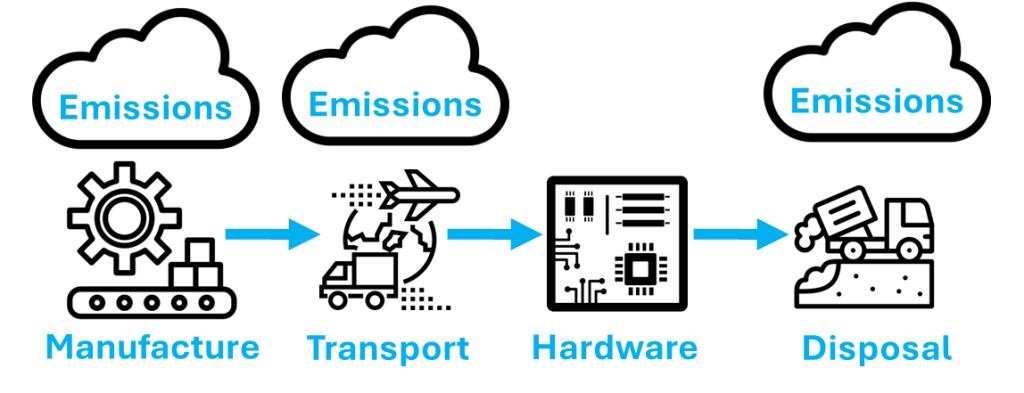
Across the month of September 2024, Tailpipe’s own use of cloud computing produced 8.31 kgCO2e of emissions, of which:
1.82 kgCO2e were embodied emissions, and
6.49 kgCO2e were operational emissions.
That’s the equivalent of driving 33 miles (53 km) in a typical petrol car.
Tailpipe calculated this by assessing the eight AWS EC2 instances that it utilized across the 30 days of September 2024. These instances were: t3.micro, t2.micro, c6a.metal, c6i.metal, c7i.metal-48xl, m7g.large, t4g.nano, t4g.small.
Operational Emissions
Operational emissions result from the energy generation process that provides the electricity that cloud service providers’ data centers need to power cloud computing services.

First, let’s break down how Tailpipe calculated its operational emissions.
Instance
Using its central database, Tailpipe could identify the following variables for each instance’s hardware:
|
Instance |
CPU |
TDP |
RAM (GB) |
DDR |
GPUs |
SSD (GB) |
Instance vCPU |
Server vCPU |
NICs |
|
t3.micro |
Intel Xeon Platinum 8175M |
240 |
1 |
4 |
0 |
0 |
2 |
8 |
1 |
|
t2.micro |
Intel Xeon E5-2676 v3 |
145 |
1 |
4 |
0 |
0 |
8 |
1 |
1 |
|
c6a.metal |
AMD EPYC 7R13 |
225 |
384 |
4 |
0 |
0 |
192 |
192 |
1 |
|
c6i.metal |
Intel Xeon Platinum 8375C |
300 |
256 |
4 |
0 |
0 |
128 |
123 |
1 |
|
c7i.metal-48xl |
Intel Xeon Platinum 8488C |
385 |
384 |
5 |
0 |
0 |
192 |
192 |
1 |
|
m7g.large |
Graviton3 |
250 |
8 |
5 |
0 |
0 |
2 |
64 |
1 |
|
t4g.nano |
Graviton2 |
150 |
1 |
4 |
0 |
0 |
2 |
8 |
1 |
|
t4g.small |
Gravtion2 |
150 |
2 |
4 |
0 |
0 |
2 |
8 |
1 |
It then multiplies these variables by power draw data, depending on the CPU utilization of each of Tailpipe’s instances for every hour of the month. For example, for the m7g.large instance:
|
Component |
Total Power Draw (Wh) |
|
CPU |
1006.8 |
|
GPU |
0 |
|
RAM |
1079.77 |
|
SSD |
0 |
|
Motherboard |
954.92 |
|
NIC |
7333.8 |
|
Total |
10375.29 |
The total power draw of the m7g.large instance for the month of September 2024 is therefore 10375.29 Wh.
Network Storage
Tailpipe then adds the impact of network storage. The m7g.large instance does not have any SSDs or HDDs, so its storage is maintained on the AWS Elastic Block Storage infrastructure. In September, Tailpipe stored 57.19 GB of data in the m7g.large instance’s network storage.
This quantity is applied to the Tailpipe methodology:
((0.0029 * GB of Network Storage) * Hours of Utilization) * Power Supply Efficiency Factor
((0.0029 * 57.19) * 720) *1.1 = 131.35 Wh
Instances in the Same Data Center
Tailpipe’s m7g.large instance was based in a data center in Stockholm in September 2024. The next stage of the methodology is to add together the impacts of the instances that were based in the same data center, and the networking that originated from that data center, during the same period.
Two other Tailpipe instances were based in the Stockholm data center in September: t3.micro and t4g.nano.
|
Name |
Instance (Wh) |
Network Storage (Wh) |
|
t3.micro |
34.15 |
0.0 |
|
t4g.nano |
175.49 |
0.0 |
|
m7g.large |
10375.29 |
131.35 |
|
Total |
10584.93 |
131.35 |
Data Transfer and Networking
The impact of networking must then be calculated. Tailpipe multiplies the GB of data transferred by specific figures for each networking type, accounting for the different power draws of networking across these different networks.
Instance Networking from Stockholm
|
Type |
GB |
Formula |
Power Draw (Wh) |
|
Intra-region |
0.00 |
(0.0006 * Intra-region GB) / 1000 |
0 |
|
Inter-region |
119.86 |
(0.0006 * Inter-region GB) / 1000 |
0.00007 |
|
External |
0.71 |
(0.0058 * External GB) / 1000 |
0.000004 |
Non-Instance Networking from Stockholm
|
Type |
GB |
Formula |
Power Draw (Wh) |
|
Intra-region |
0.00 |
(0.0006 * Intra-region GB) / 1000 |
0 |
|
Inter-region |
121.03 |
(0.0006 * Inter-region GB) / 1000 |
0.00007 |
|
External |
0.64 |
(0.0058 * External GB) / 1000 |
0.000004 |
Total Operational Emissions
The complete Tailpipe operational emissions methodology is:
((Instance + Network Storage + Intra-Region Data Transfer + Intra-Region Non-Instance Networking) * PUE) + (Inter-Region Data Transfer + External Data Transfer + Inter-Region Non-Instance Networking + External Non-Instance Networking)) * Carbon Intensity * Power Transmission Losses)
Where PUE (the Power Usage Effectiveness of the Stockholm data center) is 1.1.
Adding the figures above into this formula gives the following result:
((10584.93 + 131.35 + 0 + 0) * 1.1) + (0.00007 + 0.000004 + 0.00007 + 0.000004)) = 11787.91 Wh
This figure must then be multiplied by the carbon intensity of the Swedish grid mix in September 2024. This was 0.00001984 kgCO2e/Wh.
11787.91 * 0.00001984 = 0.23 kgCO2e
After applying the same formula to the five other instances Tailpipe utilizes, Tailpipe’s total operational emissions for September 2024 worked out to be 6.49 kgCO2e.
Embodied Emissions
Tailpipe then calculates the embodied emissions of its instances. Embodied emissions are released during the manufacture, shipping and disposal of the physical hardware that hosts cloud computing services.

Taking the m7g.large instance as an example, Tailpipe first calculates the embodied emissions of the server that hosts it. This is the m7g.metal server. It takes embodied emissions values from the Green Cloud Computing study and multiplies them based on the specific hardware in the m7g.metal server.
Component | Formula | Values | Result (kgCO2e) |
CPU | CPU Units * ((CPU Die Size) * 0.0197 + 9.14) | 1 * ((347.3) * 0.0197 + 9.14) | 15.98 |
RAM | RAM Units * ((RAM Capacity/RAM Density) * 2.2 + 5.22) | 1 * ((256/22.37) * 2.2 + 5.22) | 30.4 |
SSD | SSD Units * ((SSD Capacity/SSD Density) * 2.2 + 6.34) | 0 * ((0/0) * 2.2 + 6.34) | 0 |
HDD | HDD Units * 31.11 | 0 * 31.11 | 0 |
Motherboard | 66.10 | 66.1 | 66.1 |
PSU | Power Supply Units * (Weight * 24.3) | 2 * (2.99 * 24.3) | 145.31 |
Assembly | 6.68 | 6.68 | 6.68 |
Enclosure | 150 | 150 | 150 |
Total |
|
| 430.45 |
These figures are then scaled down for the specific m7g.large instance. The instance is a virtual machine, meaning that it uses the resources of the m7g.metal server, without having physical machinery of its own.
Component | Formula | Values | Result (kgCO2e) |
CPU | 15.98 * (Instance vCPU/Server vCPU) | 15.98 * (2/64) | 0.5 |
RAM | 30.4 * (Instance Memory/Server Memory) | 30.4 * (8/256) | 0.95 |
Motherboard | 66.1 * (Instance vCPU/Server vCPU) | 66.1 * (2/64) | 2.07 |
PSU | 145.31 * (Instance vCPU/Server vCPU) | 145.31 * (2/64) | 4.54 |
Assembly | 6.68 * (Instance vCPU/Server vCPU) | 6.68 * (2/64) | 0.2 |
Enclosure | 150 * (Instance vCPU/Server vCPU) | 150 * (2/64) | 4.69 |
Total |
|
| 12.95 |
Because the m7g.large instance hosts network storage (rather than onboard storage in the SSDs or HDDs of the m7g.metal server), the impact of this needs to be added too:
Network Storage Units * 0.0028
= 57.19 * 0.0028
= 0.16
Finally, the impact of networking equipment is added. This is 10.12 kg CO2e per instance, to account for an average of two switch ports per instance.
The total embodied emissions of the m7g.large instance across its entire lifespan are therefore:
12.95 + 0.16 + 10.12 = 23.23 kgCO2e
Disposal
Tailpipe then adds the impact of disposal onto this figure. This is a 1.8% reduction in the total carbon emissions of the physical hardware:
23.23 – (23.23 * 0.018) = 22.81 kgCO2e
Time Share
The final step in the embodied emissions calculation is to factor in Tailpipe’s use of its instances as a percentage of their total 6-year lifespan.
22.81 * (customer usage period/instance lifetime)
22.81 * (720/52596) = 0.31 kgCO2e
This means that in September 2024, the m7g.large instance generated 0.31 kgCO2e through its embodied emissions, and 0.23 kgCO2e through its operational emissions – producing a total of 0.54 kgCO2e. This result is unusual in that the embodied emissions are larger than the operational emissions, which suggests that the m7g.large instance was not being utilized efficiently in this month.
The same embodied emissions formula was applied to the seven other instances that Tailpipe utilized in September. The resulting figure for Tailpipe’s total embodied emissions for September 2024 was 1.82 kgCO2e.
Find Out More
For a more detailed breakdown of how Tailpipe calculates emissions, see the Tailpipe Methodology. For an explanation of how Tailpipe can reduce an organization’s cloud spend and carbon emissions, see Tailpipe’s Recommendations.
To discuss what Tailpipe can do to measure and reduce your cloud computing spend and emissions, get in touch with us here.

Cloud computing releases CO2 into the atmosphere, contributing 1% of all global emissions – as much as the entire aviation industry produces every six months.
Cloud computing is the delivery of computing services – servers, storage, networking, software, analytics, and artificial intelligence – on-demand and accessed over the internet. It uses server hardware that is owned and operated by Cloud Service Providers, such as Amazon Web Services (AWS) or Microsoft Azure, and is characterized by that hardware being shared amongst multiple customers. These services may seem intangible to the user, but they require a vast physical network of data centers that consume increasing quantities of energy.
Emissions are the greenhouse gases released when fossil fuels are burned. These gases trap heat within the Earth’s atmosphere, causing global warming. There are seven greenhouse gases, all of which are released in the process of delivering cloud computing services. However, they are colloquially referred to as ‘carbon emissions’, because carbon dioxide (CO₂) makes up 80% of all greenhouse gas emissions (EPA, 2024). Cloud computing emissions are therefore measured in kilograms of ‘CO₂ equivalent’, a measure that factors in the damage caused by one unit of each gas compared to CO₂.
Tailpipe is one of the first organizations focused on measuring the carbon emissions of cloud computing. Its methodology calculates how much carbon is released during an organization’s use of cloud computing services and suggests methods that make cloud computing more carbon- and cost-effective.
Operational Emissions
CO2 emissions from cloud computing can be categorized in two ways: operational emissions (resulting from the energy needed to power the running of data centers) and embodied emissions (resulting from the energy needed to manufacture, transport and dispose of computing hardware).
Data centers are usually powered by national power stations – though a minority generate their own electricity. If a data center’s electricity is generated in a power station that burns fossil fuels or biomass, it will create carbon emissions. The more energy the data center demands, the greater the associated emissions. The rapid expansion of cloud computing in recent years has released hundreds of millions of tons of CO₂ (IEA, 2023).
The most effective way to reduce cloud computing emissions is therefore to power data centers with clean, renewable energy. Data centers based in countries with clean energy grids, such as Norway, Paraguay, and Nepal (Energy Monitor, 2023), will generate next to zero operational emissions. Tailpipe can help organizations identify data centers in the cloud that are powered by clean energy sources, eliminating unnecessary operational emissions as soon as services move to those lower carbon locations. Tailpipe can also suggest more energy efficient cloud services or configurations, which reduce a data center’s overall demand for electricity.
Embodied Emissions
The other form of CO2 emissions generated by cloud computing is released during the manufacture, transport and disposal of the hardware that hosts cloud services. Despite the name, cloud computing requires much of the same physical hardware as a laptop or PC, albeit modified for its specialized role of operating in the cloud. Embodied emissions therefore represent the greenhouse gases required for – or embodied in – physical devices.
The embodied emissions of cloud computing are generated in four ways – extraction, manufacture, transport, and disposal – across a complex supply chain.
Extraction: machinery that extracts the raw minerals that make up computing hardware.
Manufacture: energy generation for hardware manufacturing plants.
Transport: vehicles that move hardware and minerals from source to customer.
Disposal: hardware decaying in landfill at end-of-life.
As an example, consider a server in a data center. This server is comprised of multiple electrical components, as well as metal and plastic casing and cabling. Just one of those components – for example, a single CPU – is made from raw minerals and crude oil extracted from the earth and transported to facilities for refinement. These are then transported to a CPU manufacturing plant, and the finished CPU then transported to a server manufacturing facility. This server is then transported to a data center, where it is operational for around six years. When it reaches the end of its operational life, it is again transported to landfill, where it releases methane, a greenhouse gas, as it decays.
The best way to reduce the embodied emissions of cloud computing is largely the responsibility of cloud service providers, who must work to extend the lifespan of their hardware and to recycle components as often as possible. However, Tailpipe can suggest cloud services that will more efficiently fulfil an organization’s needs. This can reduce the quantity of hardware required, creating less demand across the carbon-intensive supply chain.
To Sum Up
Cloud computing has allowed organizations to remove computing hardware from on-site, but this does not remove their responsibility for carbon emissions. Organizations must take accountability for their environmental impact in all forms, part of which involves transparently monitoring how their use of cloud computing generates emissions.
Tailpipe exists to help organizations to do so: to understand where their emissions are coming from, to quantify in kilograms of CO₂ equivalent how much carbon they have produced, and to take action to reduce their emissions effectively and efficiently. To discuss what Tailpipe can do to measure and reduce your cloud computing spend and emissions, get in touch with us here.
